

Most people today don’t tend to put a lot of thought into the many types of buttons which are widely available in the marketplace. That is until they either have to replace a lost one or need to add some to a garment they’ve made or purchased. Either way, once you start looking into buttons, you will find that there are many styles to choose from, and determining which ones to use can be overwhelming, especially when you take into consideration that they come in various sizes, shapes, and materials.
Before we dive into the current world of buttons, let’s take a look back a little into the history of buttons. You may find it interesting to know that buttons weren’t widely adopted until the 14th century, after the invention of the buttonhole in the 13th century. Up until that point, they were largely ornamental, if they were used at all. Typically, garments were fastened together with brooches or clasps. Once they took a grasp hold on the fashion world, however, they very quickly became a way to display wealth and rank and were frequently made of gold, silver, or ivory for the highest classes of society. While those who could not afford such luxuries used buttons made from wood or shell.
As buttons became more widely adopted, they were embellished upon with ivory, tortoiseshell, and jewels. Potters and silversmiths even were known to use them on their vases. During the 19th century, a less costly steel button made its way into the market place making them even more widely available to lower classes.
Many people collect buttons today as a hobby. Whether it is for nostalgia purposes or eventual use on a garment, once you start collecting buttons, you won’t be able to stop. Storing your collection is often important to ensure they are not collecting dust or being affected by the elements. Storing groups of buttons in clear bags within a covered basket will help keep them pristine. Sewing baskets will help you keep your buttons stored neatly.
Fast-forward to the fashion world today, and you will find a vast array of options available in the industry. The following information is sorted first by information regarding choosing the right size of a button, followed by the design of the buttons, meaning their function, and then by the materials they can be comprised of.
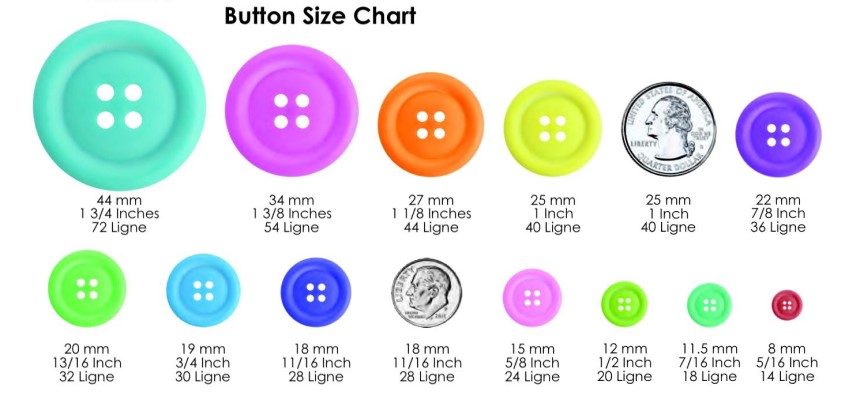 The most important question to be answered when beginning your quest for buttons is the size required for your project. Once you’ve made that decision, you can move on to the design aspect of the buttons.
The most important question to be answered when beginning your quest for buttons is the size required for your project. Once you’ve made that decision, you can move on to the design aspect of the buttons.
The size of the button will be dependent upon whether you are replacing an existing button, have a pattern that requires a specific size, or if you are simply adding buttons strictly of a decorative nature.
If you are replacing an existing button, simply measure the original button if you have it, or you can always measure the garments buttonhole. This will point you in the direction of the size you will need. For general guidelines when measuring your existing buttonholes to determine the size button, you should reference the following:
If you are adding buttons to a garment that doesn’t provide you with directions to include them, you will need to determine the number and position of the buttons to properly assess the size you should use.
Good buttonhole practices to live by when adding them into a garment include making a test buttonhole in the fabric that is as close to your actual garment as possible and the appropriate place for buttons. What I mean by that is on women’s garments, buttons are on the left front of a garment, and the buttonholes are on the right front. For men’s garments, it is the exact opposite. The most popular theory for this is that men were used to holding weaponry while dressing and needed their buttons on the right-side allowing for easier access between their swords and guns, although this has not been proven to be entirely accurate.
Button sizing is handled through a measurement referred to as “ligne.” It is a very small measurement taken across the diameter of a button. Button size is written as a number followed by an L. The American Sewing Guild Trusted Source Button and Buttonhole Positioning Button and buttonhole placements can sometimes be confusing. If the button and buttonhole are placed incorrectly, the garment may be too tight, too loose, or create gaping. www.asg.org has a lot of great information regarding the best way to place buttons within a project.
Design is another important element of your decision; the type of button design can subtly or drastically increase the aesthetic of a garment after all. Below you will find a list of the most commonly used button designs available for purchase today. When looking for the right design of a button, you are going to want to keep in mind how you want the garment to drape, is it comprised of a heavier fabric or a lighter fabric, and finally is the shape of the garment going to put any stress on the buttons that are being used.
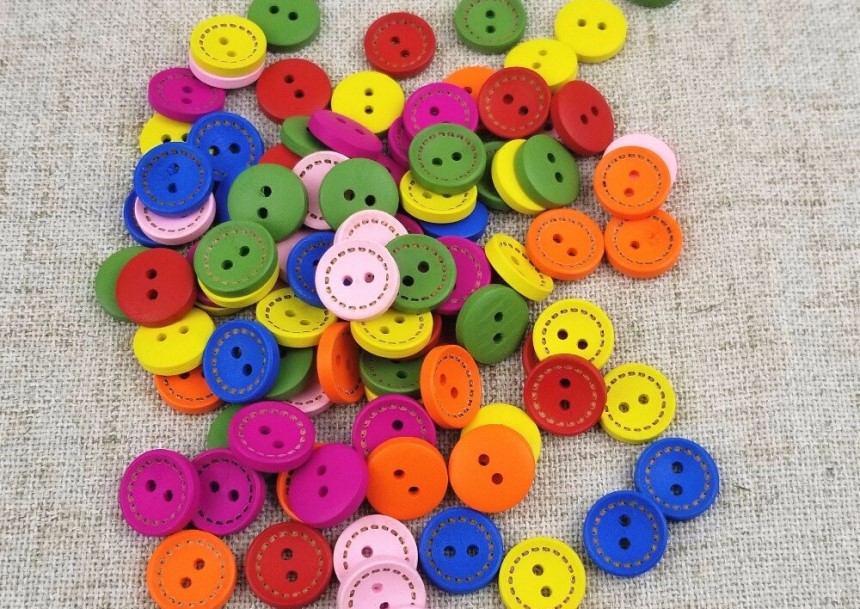 Flat buttons are adeptly named as they will lay flat against the garment they are attached to. These types of buttons are one of today’s most commonly used and come in a wide range of colors and sizes. They are sometimes referred to as buttons with visible holes. Generally speaking, they tend to have 2 or 4 holes, which are used to fasten the button to the material using sewing thread. The manufacturing process of flat buttons is quite simple and can be made from metal, wood, plastic, and many other materials.
Flat buttons are adeptly named as they will lay flat against the garment they are attached to. These types of buttons are one of today’s most commonly used and come in a wide range of colors and sizes. They are sometimes referred to as buttons with visible holes. Generally speaking, they tend to have 2 or 4 holes, which are used to fasten the button to the material using sewing thread. The manufacturing process of flat buttons is quite simple and can be made from metal, wood, plastic, and many other materials.
Given the simplicity of the process to create these buttons, the sky truly is the limit when it comes to what they could potentially be made from. Flat buttons are used in a variety of garments, including formal wear, such as men’s dress shirts. A general rule of thumb for application is that the 2-hole flat button should be used for lighter garments, and the 4-hole flat button should be used for heavier garments. Flat buttons are also a preferred button type by large manufacturers as they can be attached to the garments with a sewing machine or by hand.
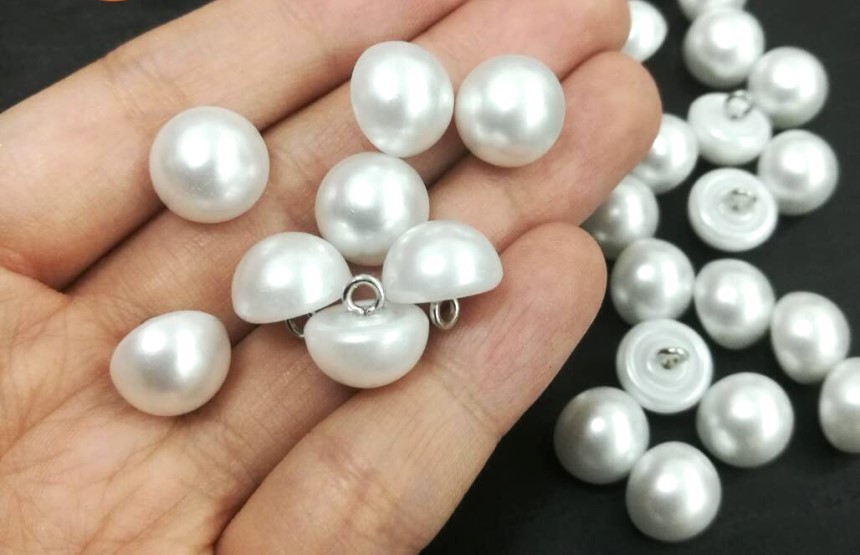 While you might not have heard this term previously, you have likely seen or even used shank buttons in your everyday life. These buttons do not have holes that you can see from the front and are attached to the garment through a shank, hence the name. They do not lay flat against the garment and are slightly raised from the fabric. A shank button has a hollow protrusion on the back of the button, which is used to attach it to the garment. These buttons tend to be widely used on jackets, coats, or any garment comprised of thicker materials. They are also commonly used as decorative details on garments as they come in a wide variety of materials, colors, and shapes. Shank buttons provide a very elegant look to any garment they are used with. They are very durable and will remain attached to the garment even when put to the test.
While you might not have heard this term previously, you have likely seen or even used shank buttons in your everyday life. These buttons do not have holes that you can see from the front and are attached to the garment through a shank, hence the name. They do not lay flat against the garment and are slightly raised from the fabric. A shank button has a hollow protrusion on the back of the button, which is used to attach it to the garment. These buttons tend to be widely used on jackets, coats, or any garment comprised of thicker materials. They are also commonly used as decorative details on garments as they come in a wide variety of materials, colors, and shapes. Shank buttons provide a very elegant look to any garment they are used with. They are very durable and will remain attached to the garment even when put to the test.
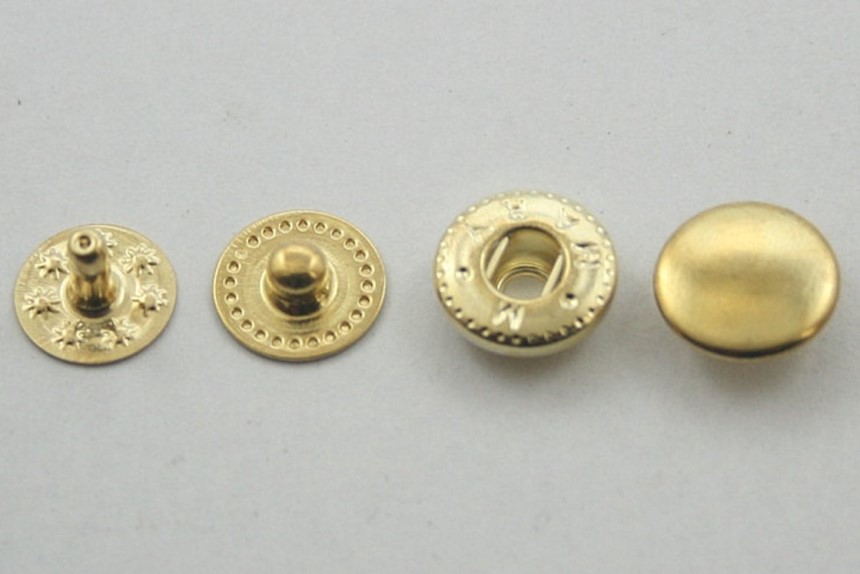 Stud buttons are typically used on jeans and are even sometimes referred to as ‘jean’s buttons. Don’t be fooled by the name, though, and they can be used on other denim items such as jackets. These types of buttons are comprised of 2 parts and are pressed into the fabric with specific machinery. They are incredibly strong, and it is virtually impossible to remove them from the fabric once they are installed. They are not commonly used outside of the manufacturing world. You can, however, get the hand-held version of the equipment used to install them yourself should you so choose from many places online or even at your local craft store. They come in a variety of sizes but are typically round and are made from metal. You can find them in a selection of colors, and they can be used on other garments aside from jeans. These types of buttons tend to be extremely sturdy and long-lasting.
Stud buttons are typically used on jeans and are even sometimes referred to as ‘jean’s buttons. Don’t be fooled by the name, though, and they can be used on other denim items such as jackets. These types of buttons are comprised of 2 parts and are pressed into the fabric with specific machinery. They are incredibly strong, and it is virtually impossible to remove them from the fabric once they are installed. They are not commonly used outside of the manufacturing world. You can, however, get the hand-held version of the equipment used to install them yourself should you so choose from many places online or even at your local craft store. They come in a variety of sizes but are typically round and are made from metal. You can find them in a selection of colors, and they can be used on other garments aside from jeans. These types of buttons tend to be extremely sturdy and long-lasting.
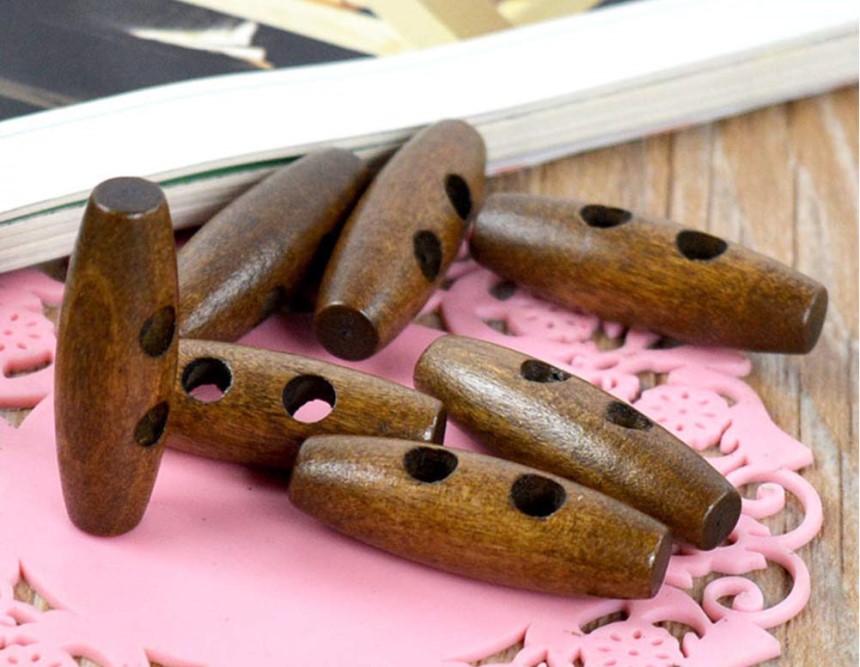 These types of buttons come in an elongated shape and typically have two centered holes to secure them to the garment. You will see them adorned with jackets or sweaters and fastened with loops. They are typically made from wood or plastic and are available in many colors and sizes. They are typically unique as they are decorative and not as functional as some of the other button varieties available today.
These types of buttons come in an elongated shape and typically have two centered holes to secure them to the garment. You will see them adorned with jackets or sweaters and fastened with loops. They are typically made from wood or plastic and are available in many colors and sizes. They are typically unique as they are decorative and not as functional as some of the other button varieties available today.
One of the wonderful things about toggle buttons is that they don’t require buttonholes in the garment. In fact, they are rarely required when using these types of buttons. If you have a garment that is slightly too large or won’t remain shut, you can easily add toggle buttons to it so that you can now close the garment. They can be made from many kinds of materials, such as natural horn or resin that looks like a horn.
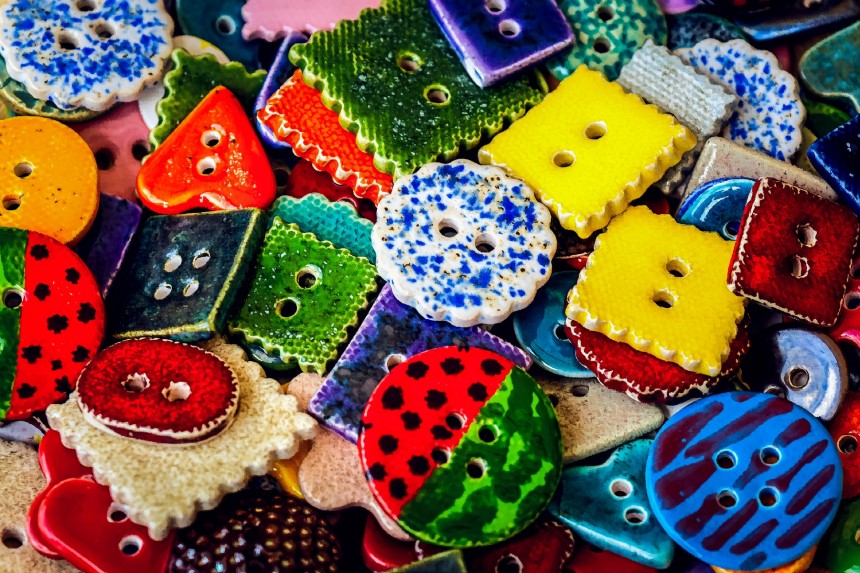 Thanks to the internet, you can find all kinds of decorative buttons for your garments! It truly can be amazing and overwhelming at the same time. You can find lapel buttons, hook and eye buttons, and so many other kinds. Below you will find a brief overview of all the various types of buttons available in the marketplace. These are by no means the only ones that are available, so if you can dream, I am certain you can find it in the form of a button if you search hard enough.
Thanks to the internet, you can find all kinds of decorative buttons for your garments! It truly can be amazing and overwhelming at the same time. You can find lapel buttons, hook and eye buttons, and so many other kinds. Below you will find a brief overview of all the various types of buttons available in the marketplace. These are by no means the only ones that are available, so if you can dream, I am certain you can find it in the form of a button if you search hard enough.
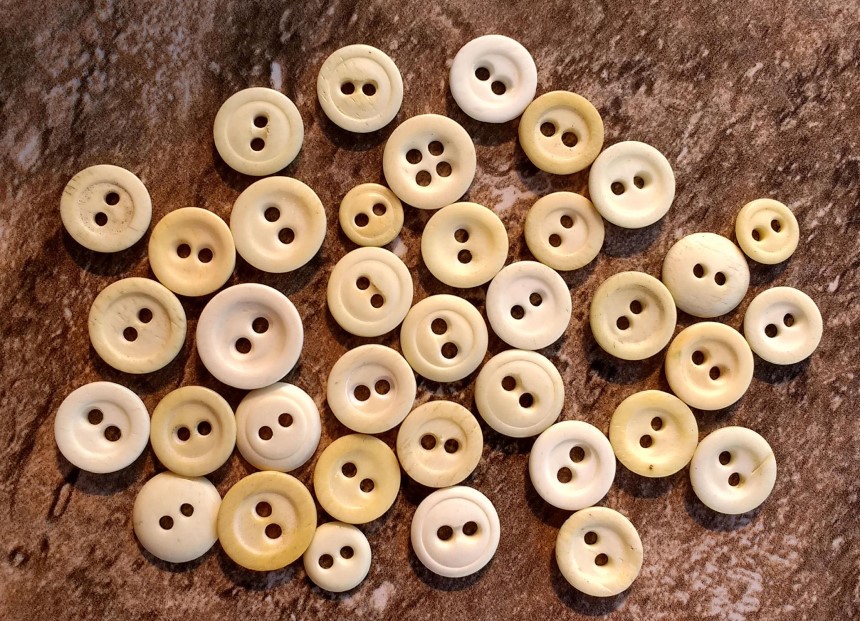 As discussed earlier in the article, two-hole buttons are commonly flat buttons. They can come in any shape, size, or color you can think of. The possibilities truly are endless when it comes to the two-hole button. A word of warning, should you choose a cute button in shape, such as a fish, you might have a harder time getting it through the buttonhole. The best thing to do if you are looking for an unusual shape is to have the garment on hand with you when you are shopping. If you are buying your buttons online, check the return policies before you complete your purchase, just in case they don’t end up working out. Two-hole buttons are typically used in women’s and girl’s garments.
As discussed earlier in the article, two-hole buttons are commonly flat buttons. They can come in any shape, size, or color you can think of. The possibilities truly are endless when it comes to the two-hole button. A word of warning, should you choose a cute button in shape, such as a fish, you might have a harder time getting it through the buttonhole. The best thing to do if you are looking for an unusual shape is to have the garment on hand with you when you are shopping. If you are buying your buttons online, check the return policies before you complete your purchase, just in case they don’t end up working out. Two-hole buttons are typically used in women’s and girl’s garments.
 Like two-hole buttons, four-hole buttons are fairly common and are typically flat button types. They are also available in any shape, size, or color you can think of. The same advice provided earlier under the two-hole buttons is also applicable here. Four-hole buttons are typically used in men’s and boy’s garments. Four-hole buttons were introduced during the industrial revolution when brass buttons gained popularity.
Like two-hole buttons, four-hole buttons are fairly common and are typically flat button types. They are also available in any shape, size, or color you can think of. The same advice provided earlier under the two-hole buttons is also applicable here. Four-hole buttons are typically used in men’s and boy’s garments. Four-hole buttons were introduced during the industrial revolution when brass buttons gained popularity.
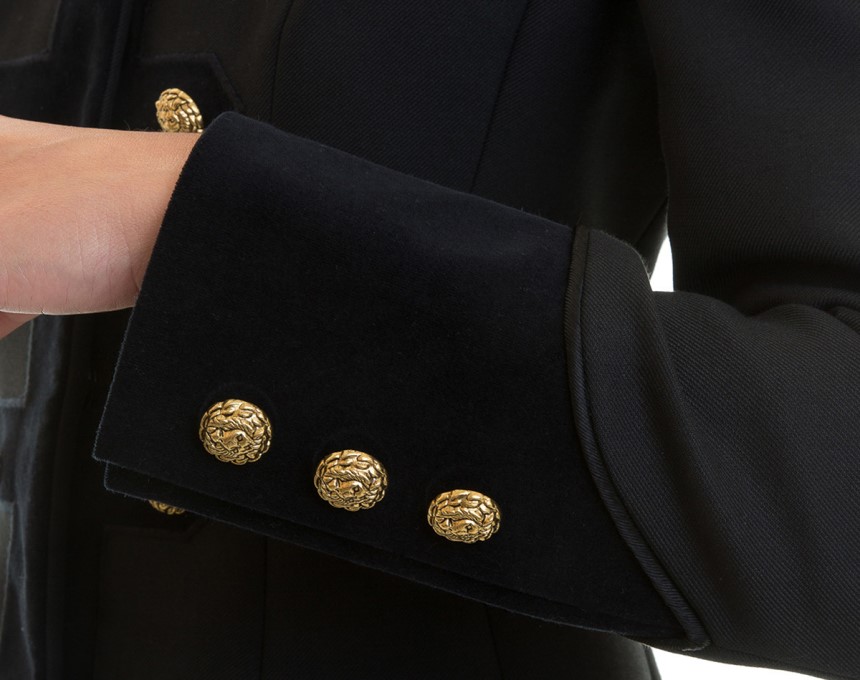 Determining the style you’re looking for with your coat will help guide you to the right coat buttons. Generally speaking, these will likely be either shank buttons or toggle buttons. That’s not to say that a flat button will not work. They will, especially if they are on the larger side. It truly depends on the style you are attempting to obtain. It is also important to determine how you want your coat to fit. If your coat is meant to be buttoned up tight to protect you against harsh winds, you will likely want a shank or flat button. If you are looking for a summer coat that is loose-fitting, a toggle button might be a better choice. Whichever way you decide to go, you are going to want to look for a sturdy button that does not have a lot of giving and is the appropriate size.
Determining the style you’re looking for with your coat will help guide you to the right coat buttons. Generally speaking, these will likely be either shank buttons or toggle buttons. That’s not to say that a flat button will not work. They will, especially if they are on the larger side. It truly depends on the style you are attempting to obtain. It is also important to determine how you want your coat to fit. If your coat is meant to be buttoned up tight to protect you against harsh winds, you will likely want a shank or flat button. If you are looking for a summer coat that is loose-fitting, a toggle button might be a better choice. Whichever way you decide to go, you are going to want to look for a sturdy button that does not have a lot of giving and is the appropriate size.
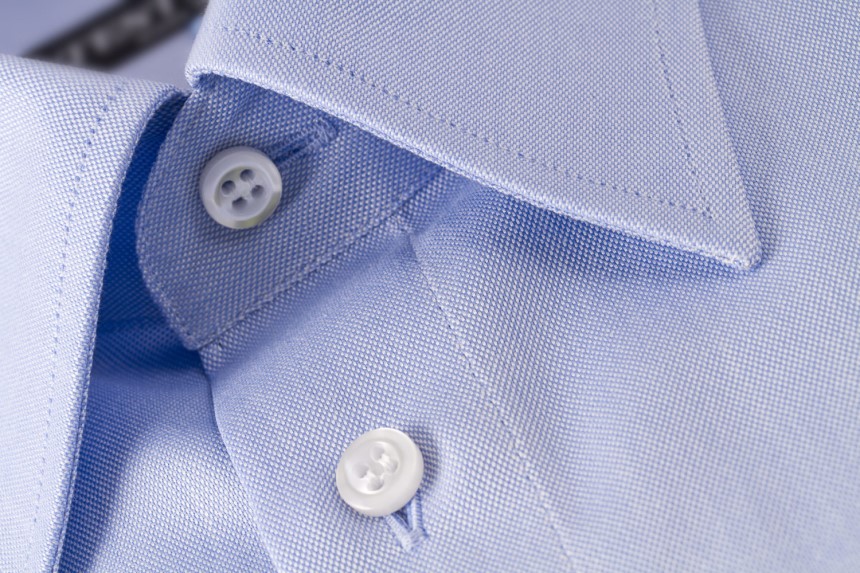 The type of shirt you are working with will drive your decision on what shirt buttons to key an eye out for. If you have a dress shirt, keep in mind that they are typically worn with a tie or jacket or perhaps both, so you will want to look for smaller flat buttons. If, however, you have a dress shirt that is not meant to be worn with a tie or jacket, you can decide to go with a shank button instead. It depends on your style preferences as well as the preferences of the intended wearer. If your garment is intended to be worn without a tie or jacket, such as a polo shirt, it is entirely up to your which buttons to use. On a dress shirt, you will typically find eight buttons, while on a polo shirt, you may find 2 or 3 buttons.
The type of shirt you are working with will drive your decision on what shirt buttons to key an eye out for. If you have a dress shirt, keep in mind that they are typically worn with a tie or jacket or perhaps both, so you will want to look for smaller flat buttons. If, however, you have a dress shirt that is not meant to be worn with a tie or jacket, you can decide to go with a shank button instead. It depends on your style preferences as well as the preferences of the intended wearer. If your garment is intended to be worn without a tie or jacket, such as a polo shirt, it is entirely up to your which buttons to use. On a dress shirt, you will typically find eight buttons, while on a polo shirt, you may find 2 or 3 buttons.
 Lapel buttons are also referring to as lapel pins or enamel pins. These are not actually sewn into the garment they adorn. They are typically removable. They are smalls buttons or pins which are often worn on the lapel of a jacket. They can also be attached to a bag or piece of fabric. You’ve likely seen them in association to the wear’s affiliations, such as a particular organization or cause. They are largely popular with political affiliations. In-fact military affiliations often use lapels buttons on their uniforms. It’s also common for corporations and organizations to use lapel business to indicate the status of a member within the group. They are largely inexpensive, which is attractive to companies who use them as an incentive to recognize hard work or status within a corporation. They are available in a large assortment of sizes and shapes. You will find some under an inch in diameter and some as large as three inches in diameter. There are many kinds of lapel buttons or pins available in the marketplace today, some that even spin. Given their adaptable nature, you can get a lapel button in any size, shape, or image you can come up with, including a company logo.
Lapel buttons are also referring to as lapel pins or enamel pins. These are not actually sewn into the garment they adorn. They are typically removable. They are smalls buttons or pins which are often worn on the lapel of a jacket. They can also be attached to a bag or piece of fabric. You’ve likely seen them in association to the wear’s affiliations, such as a particular organization or cause. They are largely popular with political affiliations. In-fact military affiliations often use lapels buttons on their uniforms. It’s also common for corporations and organizations to use lapel business to indicate the status of a member within the group. They are largely inexpensive, which is attractive to companies who use them as an incentive to recognize hard work or status within a corporation. They are available in a large assortment of sizes and shapes. You will find some under an inch in diameter and some as large as three inches in diameter. There are many kinds of lapel buttons or pins available in the marketplace today, some that even spin. Given their adaptable nature, you can get a lapel button in any size, shape, or image you can come up with, including a company logo.
In more recent years, they have been a collector’s item for many and can be found in all kinds of characters, shapes, and sizes. You can even find a mickey mouse or betty boop one if you search hard enough. If you are a collector or wish to become a collector, check out your local thrift stores for older lapel buttons.
 Hook and eye buttons are ineptly named as they not truly buttons. They are fasteners used in high-stress areas of garments, such as waistlines and neck openings. They are typically grouped together with buttons as they are very similar in nature. They come with two parts, the first is a hook, and the second is the flattened eye made from the same material as the hook. The hook will fit into the eye. They have been around for quite a long time, and you’ve likely seen them in use on the back of a bra. They are also used in other lingerie pieces, including brassieres, bustiers, and corsets. They range in size from No. 1 (small) to No. 10 (large). You may also decide to use a single hook-and-eye button closure to reduce stress on a zipper in a dress, skirt, or pants. They are typically made from metal, stainless steel to be precise, and are nylon coated to ensure they will last and not produce rust on the garment when washed. They are incredibly inexpensive and are generally hidden under a garment. They are also easy to install, making them a great choice for beginners. You can find these buttons in any hobby, department, novelty, or specialty store.
Hook and eye buttons are ineptly named as they not truly buttons. They are fasteners used in high-stress areas of garments, such as waistlines and neck openings. They are typically grouped together with buttons as they are very similar in nature. They come with two parts, the first is a hook, and the second is the flattened eye made from the same material as the hook. The hook will fit into the eye. They have been around for quite a long time, and you’ve likely seen them in use on the back of a bra. They are also used in other lingerie pieces, including brassieres, bustiers, and corsets. They range in size from No. 1 (small) to No. 10 (large). You may also decide to use a single hook-and-eye button closure to reduce stress on a zipper in a dress, skirt, or pants. They are typically made from metal, stainless steel to be precise, and are nylon coated to ensure they will last and not produce rust on the garment when washed. They are incredibly inexpensive and are generally hidden under a garment. They are also easy to install, making them a great choice for beginners. You can find these buttons in any hobby, department, novelty, or specialty store.
The material the buttons are made from is also equally important when deciding on which type of button you should purchase for your garment. You can add a touch of sophistication to your garment through the addition of a pearl button or go for an adorable look on a child’s sweater with the addition of plastic buttons in the shapes of caterpillars. In the last portion of this article, we will review the various materials a button can be made from.
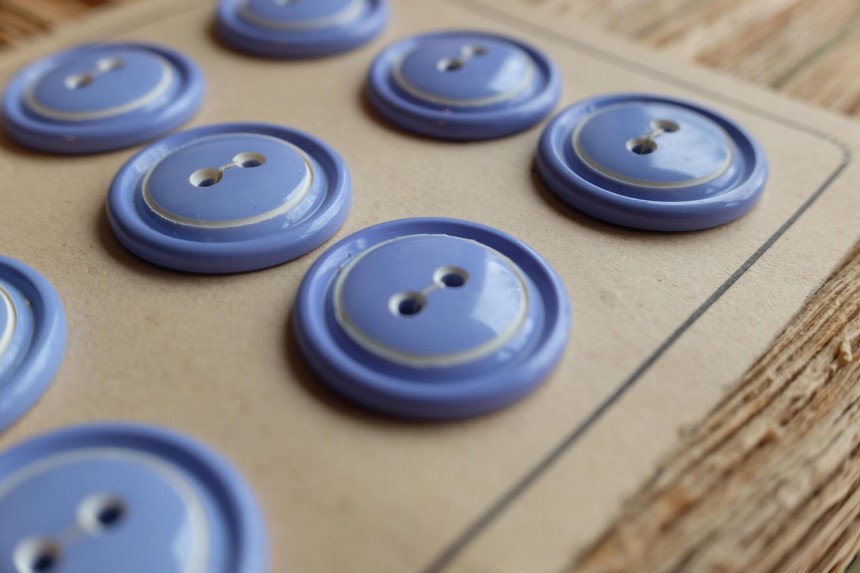 Plastic buttons entered the fashion space after the industrial revolution, which enabled manufacturers to be able to easily and cheaply produce them on a mass scale. Polyester buttons are a widely popular choice for manufacturers as they are cost-effective and can be made to look like many other more expensive materials, such as shells or wood. It is such a versatile plastic that it can be dyed to match any color imaginable and shaped to match just about anything. Red carbonate is sometimes added to polyester buttons to add a pearlescent sheen.
Plastic buttons entered the fashion space after the industrial revolution, which enabled manufacturers to be able to easily and cheaply produce them on a mass scale. Polyester buttons are a widely popular choice for manufacturers as they are cost-effective and can be made to look like many other more expensive materials, such as shells or wood. It is such a versatile plastic that it can be dyed to match any color imaginable and shaped to match just about anything. Red carbonate is sometimes added to polyester buttons to add a pearlescent sheen.
Plastic buttons remain the most popular button choice today amongst shoppers as well, due to the vast array of options available in the marketplace as well as the fact that they aren’t hard on their wallets either. You can also find quite a lot of plastic buttons which have been created to resemble a child’s favorite character or perhaps your favorite fruit. Plastic buttons can be used to play up a garment if you want to go a fancy route, or they can blend in easily to the fabric and hardly be noticed as you can get them in any color you choose.
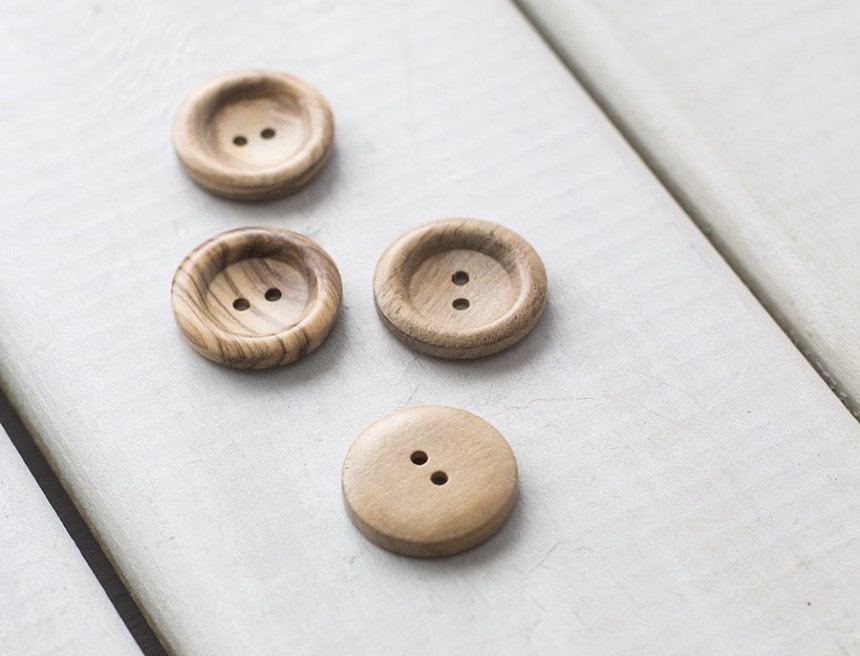 Wooden buttons aren’t as extensively used today as they were in previous decades, but they still offer you some wonderful options and are available in a wide variety of colors and sizes. When it comes to shaping availability, you can get around oval, octagon, square, rectangular, and much more. Many types of woods can be used to create buttons. They can be used in any application you like as they are quite sturdy but are also lightweight. Wooden buttons are also available in many textures ranging from smooth to rough and can be painted in many ways. They are also incredibly durable. If you decided to go the wooden button route, you could be sure they will be noticed on a garment.
Wooden buttons aren’t as extensively used today as they were in previous decades, but they still offer you some wonderful options and are available in a wide variety of colors and sizes. When it comes to shaping availability, you can get around oval, octagon, square, rectangular, and much more. Many types of woods can be used to create buttons. They can be used in any application you like as they are quite sturdy but are also lightweight. Wooden buttons are also available in many textures ranging from smooth to rough and can be painted in many ways. They are also incredibly durable. If you decided to go the wooden button route, you could be sure they will be noticed on a garment.
 You can find both leather and faux leather buttons available for purchase in the market today. They are typically used in application on jackets or heavy sweaters as they are highly durable and can take the stress associated with the frequent use of a beloved garment. One of the original leather buttons designed earned the nickname of a football button as it resembled the old leather football used during those times. Both leather and faux leather buttons are available in various shapes and sizes, including round, square, oval, rectangular, and domed. They are also available with many finishing options, such as woven leather or suede leather. Leather buttons can be made from natural cowhide, pigskin, or sheepskin. It’s important to know that quality can sometimes be an issue in the market, and you should definitely read reviews before purchasing any buttons noted as genuine leather. Leather buttons add a level of sophistication to any piece they are adorned to.
You can find both leather and faux leather buttons available for purchase in the market today. They are typically used in application on jackets or heavy sweaters as they are highly durable and can take the stress associated with the frequent use of a beloved garment. One of the original leather buttons designed earned the nickname of a football button as it resembled the old leather football used during those times. Both leather and faux leather buttons are available in various shapes and sizes, including round, square, oval, rectangular, and domed. They are also available with many finishing options, such as woven leather or suede leather. Leather buttons can be made from natural cowhide, pigskin, or sheepskin. It’s important to know that quality can sometimes be an issue in the market, and you should definitely read reviews before purchasing any buttons noted as genuine leather. Leather buttons add a level of sophistication to any piece they are adorned to.
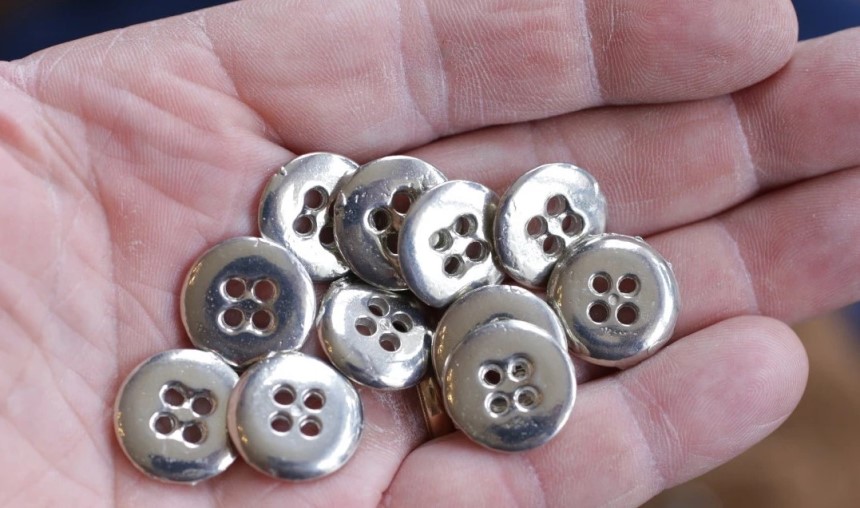 These types of buttons are incredibly common in today’s fashion world. You can find them in any kind of metal you like. Originally, they were used as a status symbol, but in today’s society, they are simply used as a fashion statement. Metal buttons can come in a variety of shapes and sizes, but they also offer a unique look as you can have custom designs stamped into them. You will find many military uniforms use brass metal buttons. You can buy them as simple or fancy as your heart desires. Regardless of the type of garment you are adorning these buttons to, and you can find something that will work perfectly. Metal buttons can be flat, shank, or stud. Stud metal buttons are typically used with heavier fabrics as they are quite durable and can withstand the stress added to form fitted garments, such as jeans.
These types of buttons are incredibly common in today’s fashion world. You can find them in any kind of metal you like. Originally, they were used as a status symbol, but in today’s society, they are simply used as a fashion statement. Metal buttons can come in a variety of shapes and sizes, but they also offer a unique look as you can have custom designs stamped into them. You will find many military uniforms use brass metal buttons. You can buy them as simple or fancy as your heart desires. Regardless of the type of garment you are adorning these buttons to, and you can find something that will work perfectly. Metal buttons can be flat, shank, or stud. Stud metal buttons are typically used with heavier fabrics as they are quite durable and can withstand the stress added to form fitted garments, such as jeans.
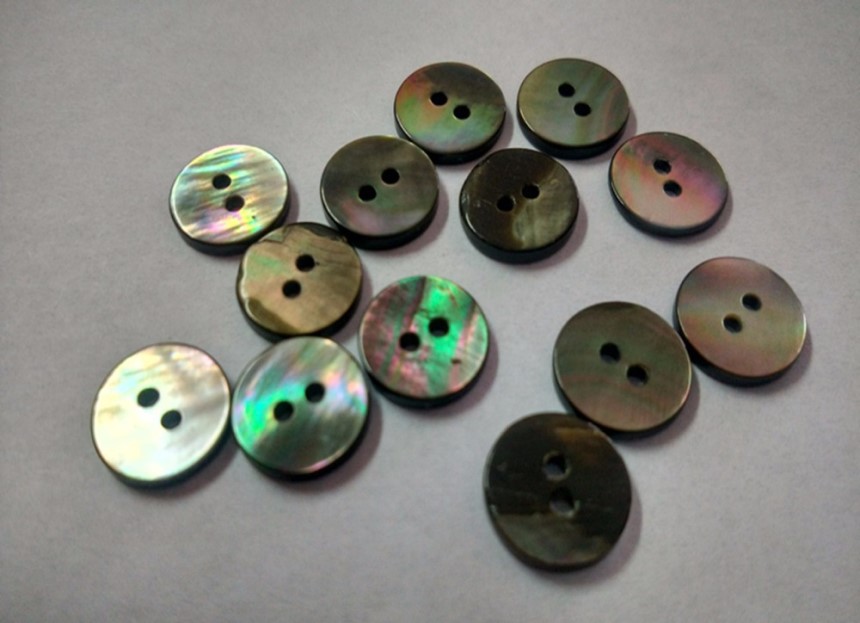 You’ve likely seen these on a cardigan or wedding dress. They are sometimes very delicate and used as a decorative addition to a garment and not a functional one. That doesn’t mean that you cannot find more sturdy versions of pearl and shell buttons, they are available, but you should make certain you are looking at the thickness of the button if you are looking for them to take on a more functional role. They can be made from real pearls, mother of pearl, or shells. If you can find it on a beach, you can turn it into a button. Most mothers of pearl buttons are white, off-white, or pale pink and typically comes from abalone or pearl oysters. They come in many shapes and sizes and can be used in casual or formal wear.
You’ve likely seen these on a cardigan or wedding dress. They are sometimes very delicate and used as a decorative addition to a garment and not a functional one. That doesn’t mean that you cannot find more sturdy versions of pearl and shell buttons, they are available, but you should make certain you are looking at the thickness of the button if you are looking for them to take on a more functional role. They can be made from real pearls, mother of pearl, or shells. If you can find it on a beach, you can turn it into a button. Most mothers of pearl buttons are white, off-white, or pale pink and typically comes from abalone or pearl oysters. They come in many shapes and sizes and can be used in casual or formal wear.
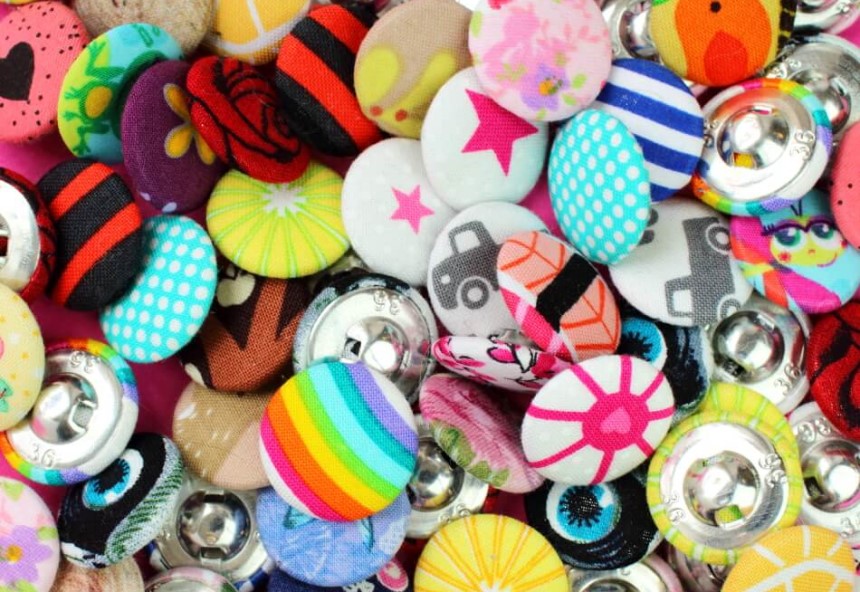 Fabric or cloth buttons are available in all kinds of colors and materials, making them incredibly versatile. They often a huge selection of options. They can be made from cotton, muslin, or any other fabric you like. Most of the time, cloth buttons are metal buttons covered in the selected material. They are usually found as shank buttons, but you can find flat buttons if you’re willing to hunt them down. Creating your buttons from scrap materials can be a fun way to introduce a new hobby into your life. There are many tutorials and kits available in the marketplace if you want to try your hand at it. When you think about the possibilities that accompany fabric buttons, the options are truly endless. Even if you don’t want to create your fabric buttons, you can find willing artists online who will happily do it for you.
Fabric or cloth buttons are available in all kinds of colors and materials, making them incredibly versatile. They often a huge selection of options. They can be made from cotton, muslin, or any other fabric you like. Most of the time, cloth buttons are metal buttons covered in the selected material. They are usually found as shank buttons, but you can find flat buttons if you’re willing to hunt them down. Creating your buttons from scrap materials can be a fun way to introduce a new hobby into your life. There are many tutorials and kits available in the marketplace if you want to try your hand at it. When you think about the possibilities that accompany fabric buttons, the options are truly endless. Even if you don’t want to create your fabric buttons, you can find willing artists online who will happily do it for you.
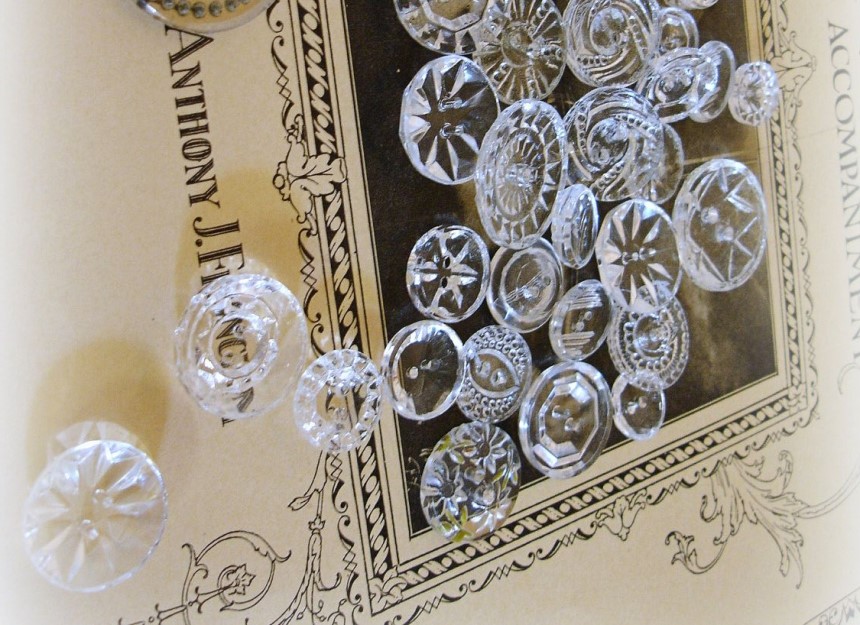 Before you toss the idea of glass buttons out the window, you should know that they in a wide variety of shapes and sizes. You can find them in unique shapes, such as a plane or tractor, or you can find them in standard round or oval shapes as well. If you aren’t having much luck finding the right shape for your garment, you can easily have glass buttons commissioned specifically for your project. Most glass buttons are not as heavy as some of the other materials that buttons are made from. They can add either loud or subtle statements to any garment. Glass buttons are derived from a material that is scratch-resistant and durable. You do not have to worry about damaging these buttons. You can certainly put them to the test in any washing machine or on any wild child. Glass buttons are very eye-catching when used in garments, and just because they are glass does not mean they are fragile.
Before you toss the idea of glass buttons out the window, you should know that they in a wide variety of shapes and sizes. You can find them in unique shapes, such as a plane or tractor, or you can find them in standard round or oval shapes as well. If you aren’t having much luck finding the right shape for your garment, you can easily have glass buttons commissioned specifically for your project. Most glass buttons are not as heavy as some of the other materials that buttons are made from. They can add either loud or subtle statements to any garment. Glass buttons are derived from a material that is scratch-resistant and durable. You do not have to worry about damaging these buttons. You can certainly put them to the test in any washing machine or on any wild child. Glass buttons are very eye-catching when used in garments, and just because they are glass does not mean they are fragile.
At the end of the day, choosing buttons for your garments is a critical choice. The right button can set the entire tone for your garment, while the wrong one can create a look that just isn’t what you were going for. Keeping a supply of buttons at your disposal is an easy way to make sure that if you aren’t quite happy with the result, you can easily change them out.
Whether you are new to the world of buttons or a novice, it’s important to have the right tools at your disposal. Sometimes finding those tools is an adventure of its own. Often it can feel overwhelming and frustrating. You end up purchasing the wrong item and feel like you’ve wasted your money. This starter kit provides you with all of the essentials and won’t break your bank account. This kit comes with essential, quality materials that will last, making it a great addition to your craft supplies.
Now that you’ve learned about all the various types of buttons available in the marketplace, you can arm yourself with the reassurance that you’ll be able to quickly purchase some new buttons for your collection. Once you’ve got the perfect buttons chosen for your next project, all you have to do is attach them, and you’ll be ready to show your project off to the world.